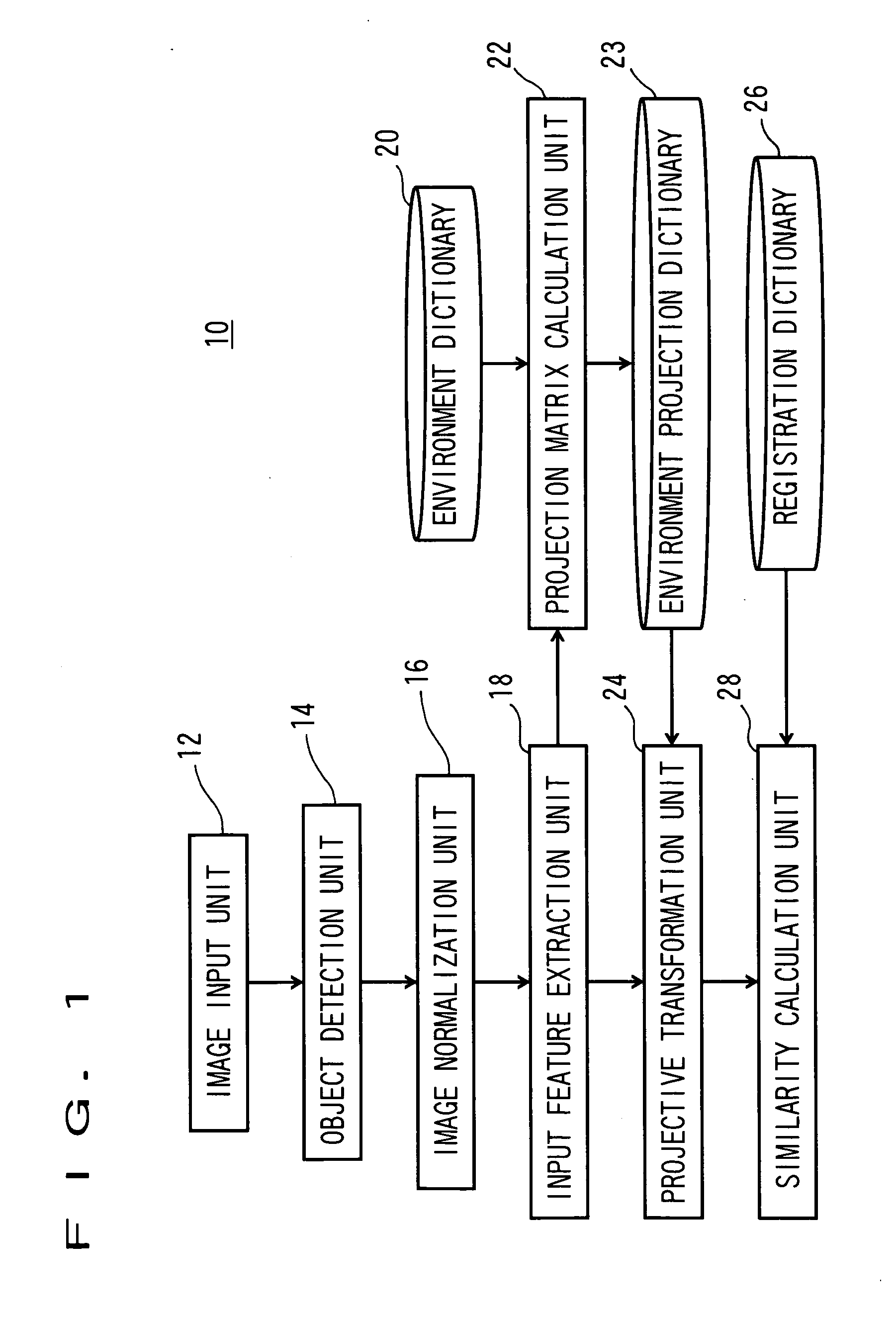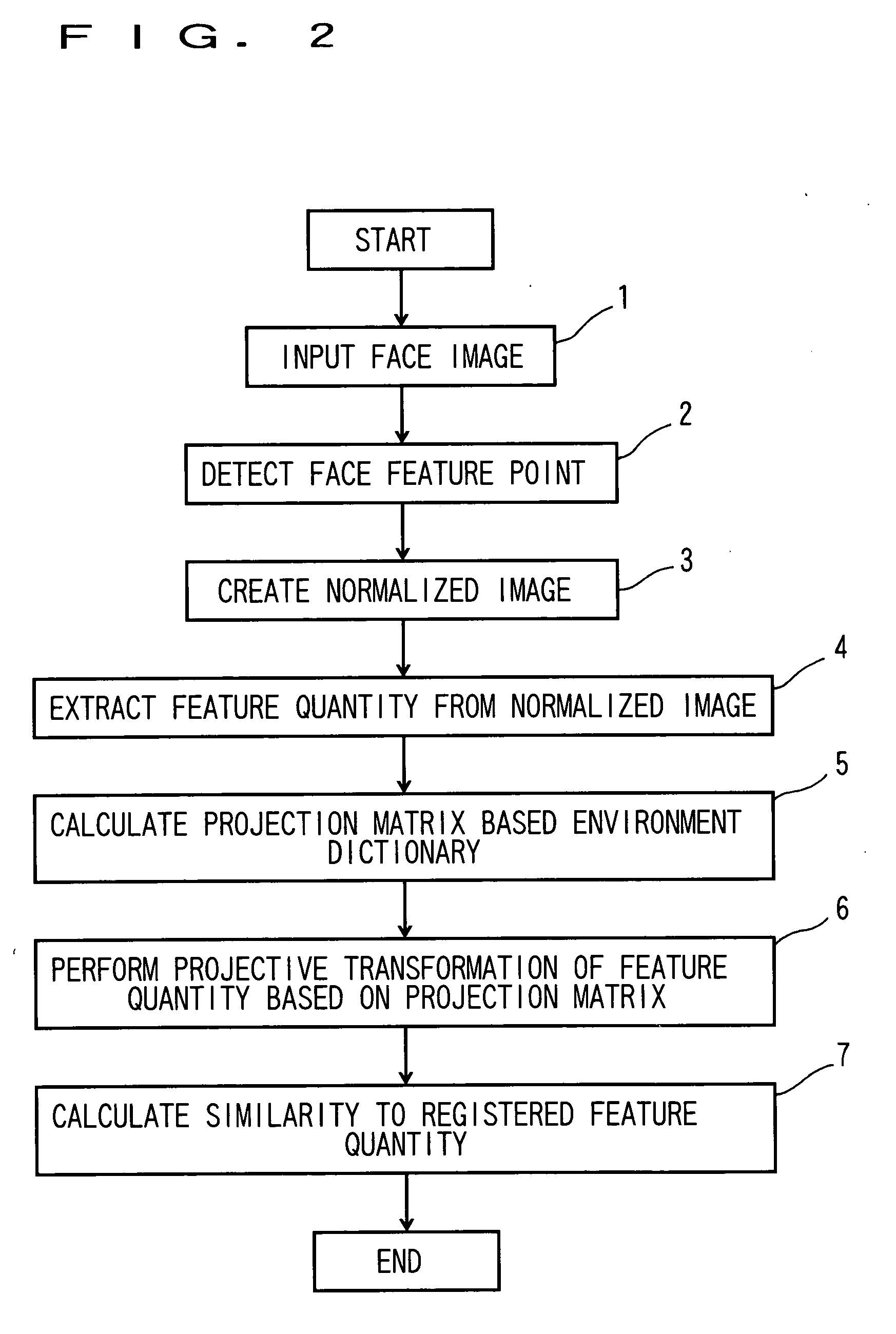Image recognition apparatus and its method
- Summary
- Abstract
- Description
- Claims
- Application Information
AI Technical Summary
Benefits of technology
Problems solved by technology
Method used
Image
Examples
first embodiment
[0018] Hereinafter, an image recognition apparatus 10 of a first embodiment of the invention will be described with reference to FIGS. 1 to 3.
[0019] (1) Structure of the Image Recognition Apparatus 10
[0020]FIG. 1 is a view showing the structure of the image recognition apparatus 10.
[0021] As shown in FIG. 1, the image recognition apparatus 10 includes: an image input unit 12 to input a face of a person as an object to be recognized; an object detection unit 14 to detect the face of the person from an inputted image; an image normalization unit 16 to create a normalized image from the detected face; an input feature extraction unit 18 to extract a feature quantity used for recognition; an environment dictionary 20 having information relating to environmental variations, a projection matrix calculation unit 22 to calculate, from the feature quantity and the environment dictionary 20, a matrix for projection onto a subspace to suppress an environmental variation; an environment proje...
second embodiment
[0057] Next, an image recognition apparatus 10 of a second embodiment of the invention will be described with reference to FIG. 4.
(1) Structure of the Image Recognition Apparatus 10
[0058]FIG. 4 is a view showing the structure of the image recognition apparatus 10.
[0059] The image recognition apparatus 10 includes: an image input unit 12 to input a face of a person which becomes an object; an object detection unit 14 to detect the face of the person from an inputted image; an image normalization unit 16 to create a normalized image from the detected face; an input feature extraction unit 18 to extract a feature quantity used for recognition; an environment dictionary 20 having information relating to environmental variations; a first projection matrix calculation unit 221 to calculate a matrix for projection onto a subspace to suppress an environmental variation from the feature quantity and the environment dictionary 20; an environment projection dictionary 23 to store the calcul...
third embodiment
[0068] Next, an image recognition apparatus 10 of a third embodiment of the invention will be described with reference to FIG. 5.
(1) Structure of the Image Recognition Apparatus 10
[0069]FIG. 5 is a view showing the structure of the image recognition apparatus 10.
[0070] The image recognition apparatus 10 includes: an image input unit 12 to input a face of a person to be recognized, an object detection unit 14 to detect the face of the person from an inputted image; an image normalization unit 16 to create a normalized image from the detected face; an input feature extraction unit 18 to extract a feature quantity used for recognition; an environment perturbation unit 32 to perturb the input image with respect to an environmental variation; an environment dictionary 20 having information relating to environmental variations; a projection matrix calculation unit 22 to calculate a matrix for projection onto a space to suppress an environmental variation from the feature quantity and t...
PUM
 Login to View More
Login to View More Abstract
Description
Claims
Application Information
 Login to View More
Login to View More - R&D
- Intellectual Property
- Life Sciences
- Materials
- Tech Scout
- Unparalleled Data Quality
- Higher Quality Content
- 60% Fewer Hallucinations
Browse by: Latest US Patents, China's latest patents, Technical Efficacy Thesaurus, Application Domain, Technology Topic, Popular Technical Reports.
© 2025 PatSnap. All rights reserved.Legal|Privacy policy|Modern Slavery Act Transparency Statement|Sitemap|About US| Contact US: help@patsnap.com



